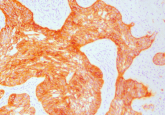Novel biosensor may be an important step towards diagnosing early-stage Parkinson’s disease
ZnO nanowire/graphene foam electrode is capable of detecting low levels of uric acid in patients with Parkinson’s disease.
Researchers from Sungkyunkwan University (Suwon, Republic of Korea), in collaboration with Harbin University of Science and Technology (Harbin, China) and Chungnam National University Hospital (Daejeon, Republic of Korea), have reported on the development of a novel biosensor capable of detecting biomarkers associated with Parkinson’s disease (PD), potentially representing a significant advance towards diagnosing PD in its early stages.
The study describes the fabrication of vertically aligned ZnO nanowire arrays on 3D graphene foam, which was used to selectively detect uric acid (UA), dopamine (DA) and ascorbic acid (AA) by a differential pulse voltammetry method.
Speaking to Future Science Group, lead researcher Young Hee Lee, from Sungkyunkwan University, explained that low levels of DA are strongly linked to neurological disorders such as PD and schizophrenia. Since DA coexists with UA and AA in serum and the extracellular fluid of the CNS, Lee commented that, using conventional solid electrodes, “It is difficult to simultaneously detect DA, UA and AA in a mixture with high selectivity and sensitivity due to overlapping oxidation potentials, insufficient surface area and/or the limited kinetic accessibility of each species.”
According to the study, the optimized ZnO nanowire/graphene foam electrode provided a high surface area and high selectivity with a detection limit of 1 nM for UA and DA. Lee commented, “The key features of our structural design are a large surface area with mesoporous 3D graphene structures to facilitate ion diffusion easily; high conductivity from 3D graphene foam; and active sites of ZnO surface for high selectivity.”
In order to carry out the analysis, serum was extracted from human peripheral blood of healthy individuals, in addition to PD patients. This process involved proton and electron generation at the surface of the ZnO nanowire arrays, causing the transfer of electrons to the electrode. Using differential pulse voltammetry measurements with the ZnO nanowire/graphene foam electrode, the samples were analyzed for UA levels. The average UA concentrations for the healthy individuals and the PD patients were 355±30 and 265±20 µM, respectively. According to Lee, “This clear reduction in UA levels in the serum of PD patients with reliable statistics (p <0.001) strongly implies that our approach is a significant step forward, which we believe will be beneficial for diagnosing PD and monitoring disease progression.”
Currently, diagnosis of PD essentially relies on the assessment of clinical symptoms and a blood test for PD is a major goal for researchers. Speaking to Future Science Group about the significance of the study, Lee commented, “Being able to accurately test for biomarkers associated with the disease with simple blood tests would be a major breakthrough in diagnosing PD in the early stages when treatments are most likely to be effective.”
In terms of future work the team intends to improve on the electrode design in order to achieve the simultaneous and accurate detection of other disease biomarkers and biomolecules. Lee added that, “Since the oxidation potential of some biomolecules may overlap, there is no guarantee that they can always succeed. Therefore, we will proceed by testing individual diseases, including cancers, in order to improve their sensor design and make it as generally applicable as possible.”
Source: Yue HY, Huang S, Chang J et al. ZnO nanowire arrays on 3D hierachical graphene foam: biomarker detection of Parkinson’s disease. ACS Nano DOI: 10.1021/nn405961p (2014) (Epub ahead of print).





